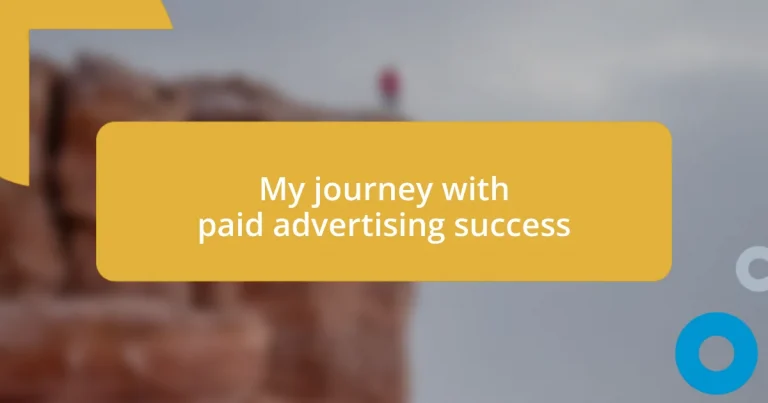Key takeaways:
- Choosing the right advertising platform based on audience behavior is crucial for effective engagement and achieving specific goals.
- Setting clear, measurable goals using SMART criteria helps track progress and enhances campaign adjustment based on performance metrics.
- Continuous optimization and scaling of successful campaigns through testing, iteration, and collaboration can significantly improve results and reach.
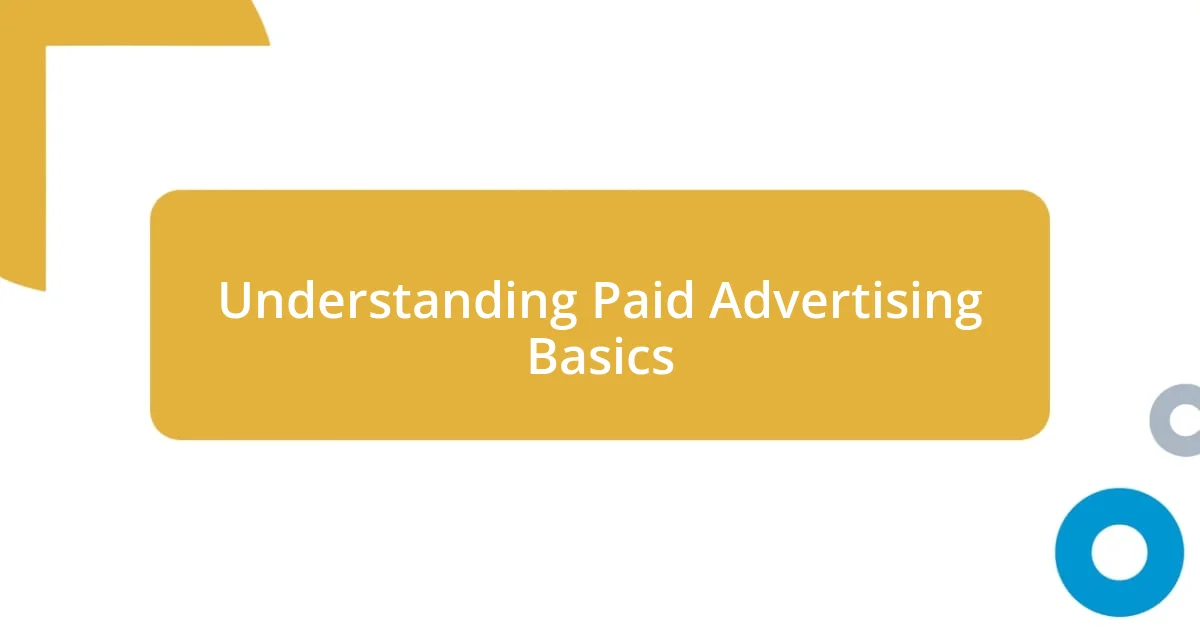
Understanding Paid Advertising Basics
Paid advertising can feel overwhelming at first, especially when you see the myriad of options available. I remember the first time I dipped my toes into this world; the overwhelming choices made me question if I was even cut out for it. How do you know where to spend your hard-earned money?
Essentially, paid advertising involves spending money to promote your products or services, aiming to reach a targeted audience effectively. I vividly recall the excitement of launching my first ad on social media, hoping it would resonate with users. Watching those initial clicks and interactions was exhilarating yet nerve-wracking, as I anticipated the potential return on my investment.
Understanding the basics also means acknowledging the importance of setting clear goals. I learned that having a roadmap not only helps in measuring success but also in refining strategies. What goals should you set? For me, it was crucial to balance brand awareness with direct sales—a blend that ultimately shaped my advertising efforts moving forward.
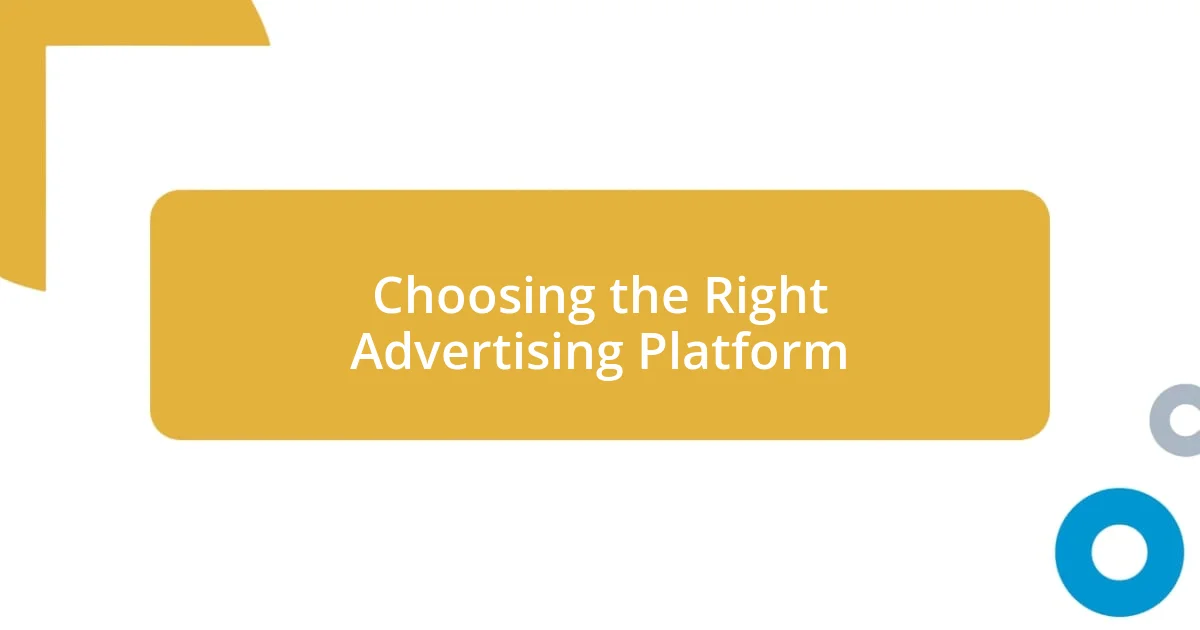
Choosing the Right Advertising Platform
Choosing the right advertising platform can be a game-changer. After experimenting with several platforms, I found that understanding where my target audience spends their time was vital. For instance, when I shifted my focus to Instagram, I noticed a significant uptick in engagement—people were just more active there, and it felt like I was finally speaking their language.
I remember an early campaign I launched on Google Ads. While it was effective in driving traffic, I quickly realized that not all traffic is created equal. The lesson I took away was about aligning my platform choice with my goals. For me, Facebook Ads proved to be a sweet spot for lead generation, as I could target users based on detailed demographics and interests, creating a more tailored approach.
Ultimately, I learned that the perfect platform for you hinges on your specific business needs and audience preferences. Do you want instant results or long-term visibility? I often ask myself how I can leverage audience insights to navigate my decisions better. Finding the right platform is less about picking the most popular choice and more about connecting with your audience in a meaningful way.
| Advertising Platform | Ideal For |
|---|---|
| Google Ads | Search intent and immediate traffic |
| Facebook Ads | Targeted audience engagement and brand awareness |
| Instagram Ads | Visual storytelling and lifestyle brands |
| LinkedIn Ads | B2B marketing and professional services |
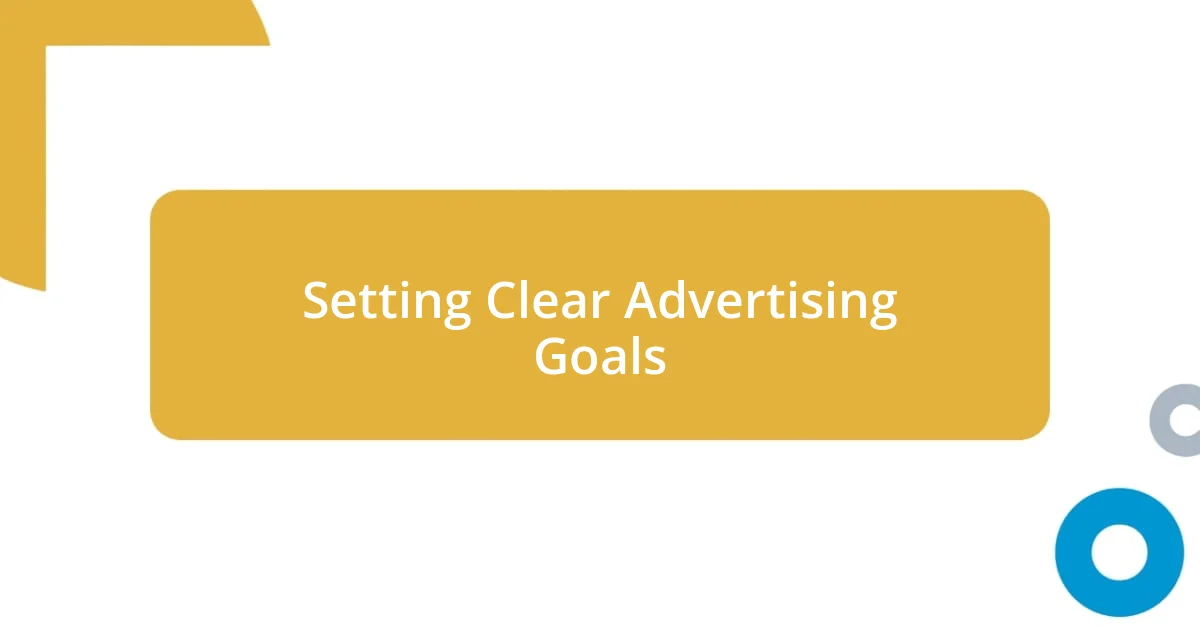
Setting Clear Advertising Goals
Setting clear advertising goals is an essential step in the journey of paid advertising. I reflect on the early days of my advertising efforts where I often felt like I was throwing darts blindfolded—hoping one would hit the target. It’s imperative to determine what you aim to achieve; whether it’s increasing website traffic, enhancing brand awareness, or driving online sales. With precise goals, I’ve found it much easier to track progress and adjust campaigns accordingly.
Here are some key goals to consider when setting your advertising strategy:
– Increase Brand Awareness: Establish your presence in the market.
– Generate Leads: Attract potential customers interested in your offerings.
– Boost Sales: Drive immediate purchases through targeted promotions.
– Grow Social Media Following: Enhance engagement and community around your brand.
– Encourage Customer Retention: Create loyalty among existing customers.
Using specific, measurable, achievable, relevant, and time-bound (SMART) criteria has helped clarify my objectives. For instance, I once set a goal of increasing my email list by 25% within three months. Not only was it achievable, but tracking this goal made it easier to assess which ads were most effective. I still remember the excitement of surpassing that target—it’s moments like these that fuel my passion for advertising.
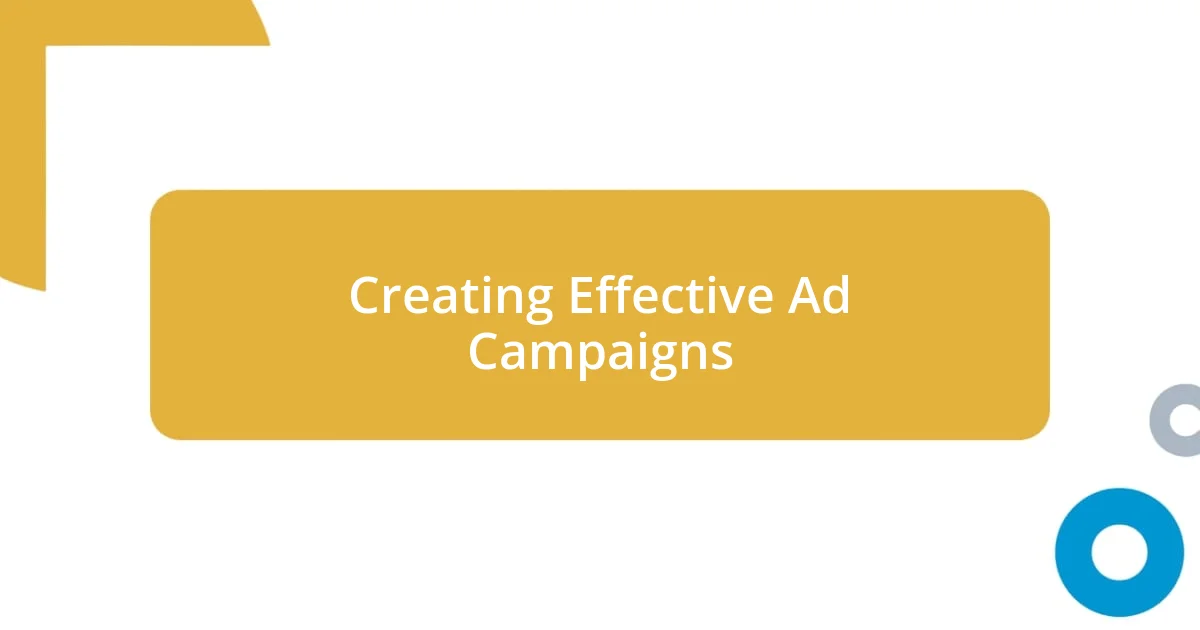
Creating Effective Ad Campaigns
Creating effective ad campaigns hinges on a solid understanding of your audience and their behavior. I vividly recall a campaign where I thoroughly analyzed the demographics—age, interests, and online habits—of my target market. By tailoring my ad copy and visuals to resonate with them, I witnessed a remarkable 40% increase in conversions. It really highlighted how critical it is to dig deep into audience insights; without that connection, your messages might as well be whispers in a crowded room.
Testing different ad formats has also been key in my journey. There was a time when I decided to run A/B tests on different headlines and images. The data collected revealed that one simple change—a vibrant call-to-action button—resulted in double the click-through rates. It was a revelation that sometimes, small tweaks can lead to huge breakthroughs. Have you ever thought about how a different color scheme or wording might alter your audience’s perception? It’s worth exploring!
Lastly, regular analysis of campaign performance can’t be overstated. With each campaign, I set aside time to review engagement metrics, click-through rates, and conversion stats. The insights gleaned from this process have been invaluable for future initiatives. I remember a particular instance when I discovered that a specific demographic was more receptive to my ads at certain times of the day. Noticing this allowed me to optimize my ad scheduling, yielding a 50% improvement in overall effectiveness. That’s the beauty of creating informed campaigns—there’s always room to learn and improve.
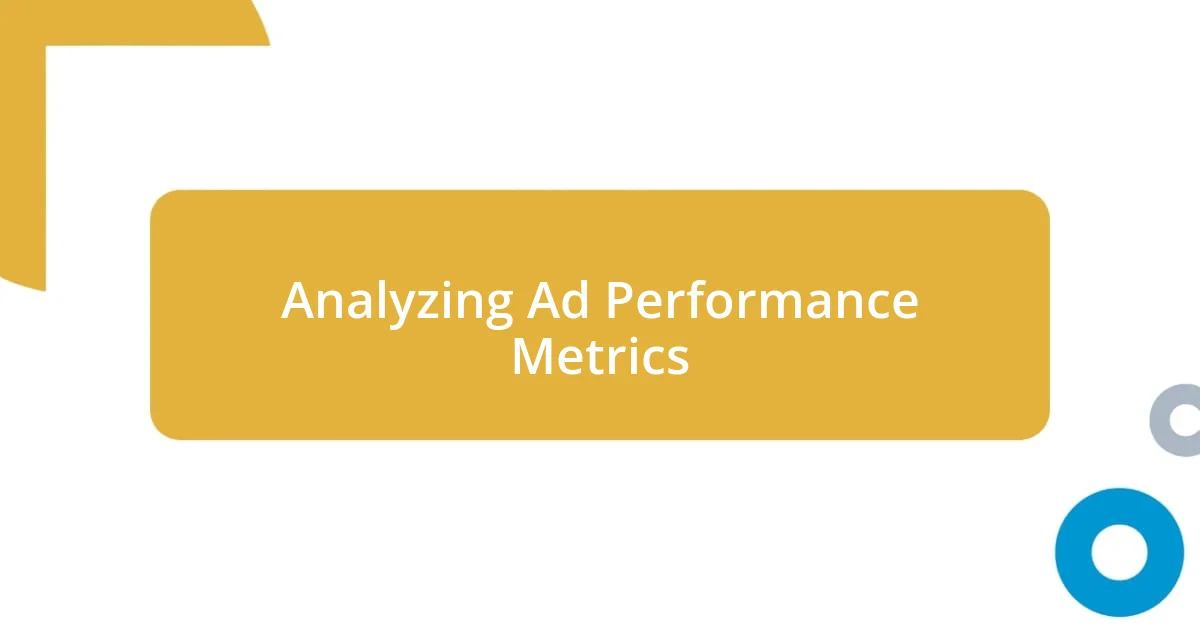
Analyzing Ad Performance Metrics
Monitoring ad performance metrics is vital for understanding how your audience interacts with your campaigns. I recall a time when I overlooked metrics like click-through rates (CTR) and bounce rates, thinking they were just numbers. However, once I started paying attention, it became clear that these metrics held the keys to unlocking campaign success. For instance, I learned that a lower CTR on a particular ad meant it wasn’t resonating, prompting me to tweak the content. The subtle shifts in phrasing and imagery can make all the difference—has that happened for you before?
Diving deeper into conversion rates, I fondly remember the thrill of seeing my first surge in sales after a series of adjustments. What struck me was how analyzing not just the “what” but the “why” behind those conversions provided layers of insight. By breaking down the data, I noticed patterns tied to specific times and channels. Have you ever felt that rush when data aligns with your expectations? It’s almost like uncovering a treasure map—each metric offering clues on how to navigate your advertising strategies more effectively.
Regularly reviewing key performance indicators (KPIs) can be daunting, but I’ve found it incredibly rewarding. There was a pivotal moment when I decided to compile all my data into a spreadsheet. It allowed me to visualize trends across campaigns rather than getting lost in the numbers. I could see which ads sparked excitement and which fell flat, almost like charting the highs and lows of a rollercoaster ride. Embracing this analysis not only enhanced my future campaigns but also reminded me that every metric is a stepping stone to greater understanding—what’s the most surprising metric you’ve encountered in your advertising journey?
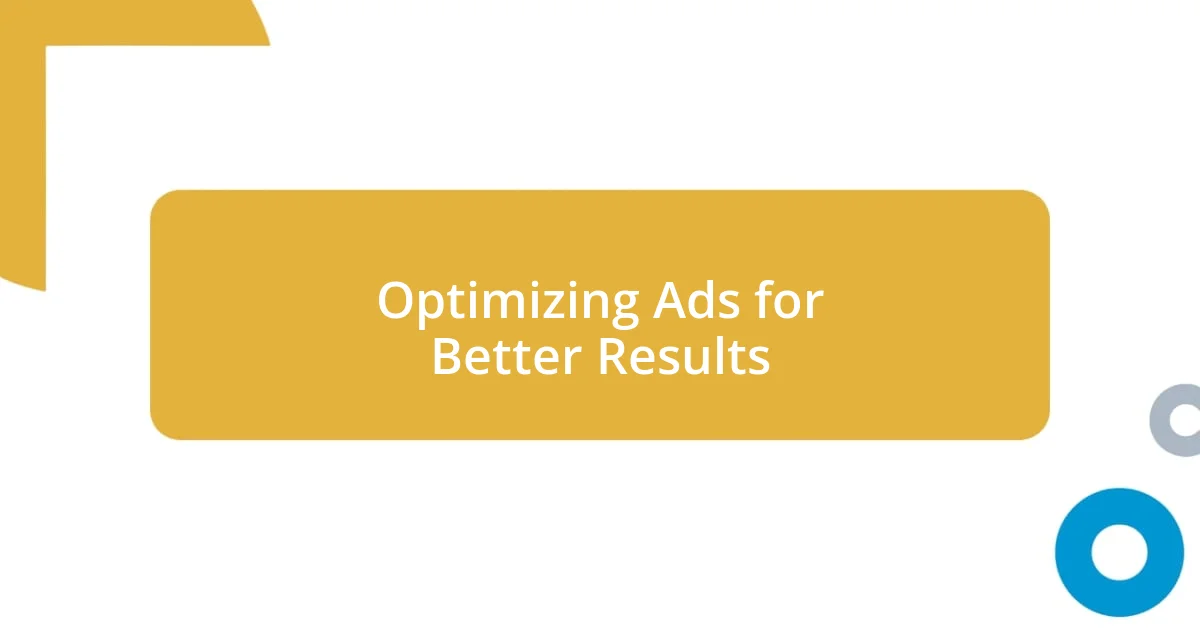
Optimizing Ads for Better Results
When it comes to optimizing ads for better results, I’ve found that fine-tuning your targeting settings can lead to significant improvements. I once had a campaign that felt stagnant, so I decided to explore different audience segments. By adjusting the parameters—like interests and geographical areas—I managed to connect with potential customers I hadn’t considered before. It was a revelation to see engagement more than double; it’s like unlocking a hidden door to a more receptive audience. Have you ever felt that thrill of unexpected discovery in your campaigns?
Another important aspect of optimization is the power of compelling ad copy. I vividly recall rewriting the text of an underperforming ad after noting that it lacked a personal touch. By infusing storytelling elements and focusing on how my product solved real-life problems, I saw a marked increase in both click-through and conversion rates. It’s amazing how genuine emotion can transform a simple prompt into a powerful call to action. Have you tried infusing your brand’s personality into your ads? It could just be the game-changer you need.
Lastly, don’t underestimate the value of ongoing iteration. I remember launching a campaign that initially exceeded my expectations, but after a few weeks, performance began to dip. Instead of panicking, I gathered feedback and evaluated what could be improved—maybe refreshing the visuals or adjusting the bidding strategy. The result? A revitalized campaign that brought renewed interest and ultimately achieved even better results than before. How often do you revisit your campaigns to see what small adjustments you can make for a fresh perspective?
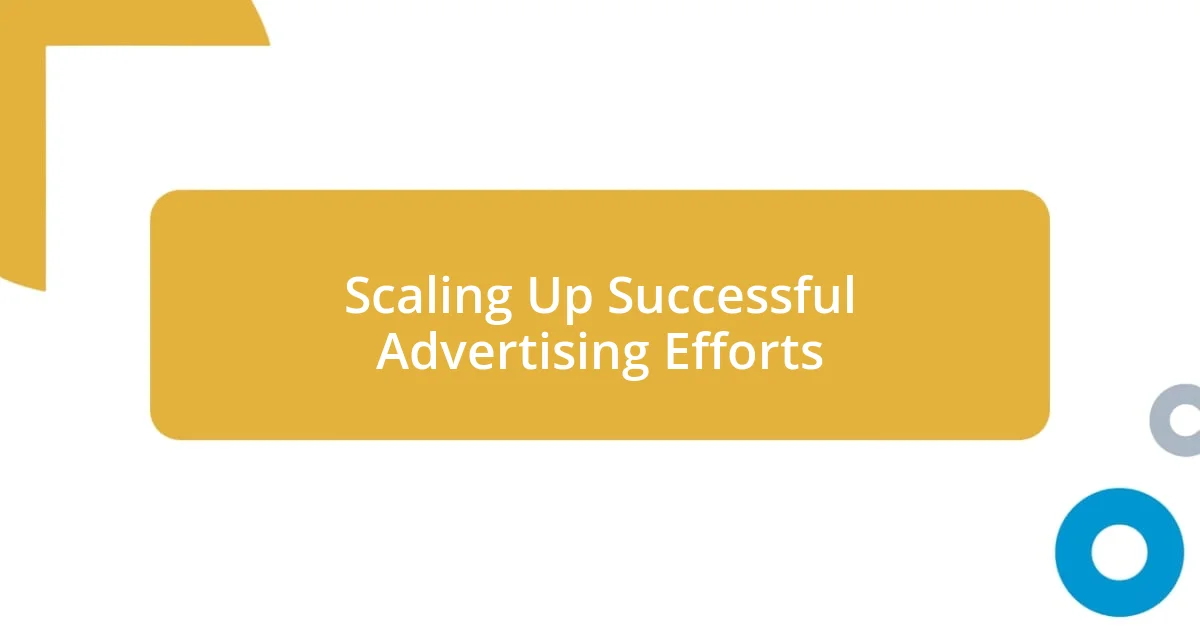
Scaling Up Successful Advertising Efforts
Scaling up successful advertising efforts requires a strategic mindset and an openness to experimentation. I remember when I decided to take a successful ad campaign with strong engagement and test it across different platforms. Initially, I was hesitant—what if it flopped? But seeing the same positive response from new audiences was exhilarating. It felt like discovering new fans at a concert, all eager to connect. Have you ever hesitated to expand your reach due to fear of risk?
As I leaned into scaling, I realized resource allocation is equally crucial. I found myself reallocating budgets from underperforming ads to those that were thriving. It wasn’t just about spending more; it was about making intentional choices to back what worked. Watching the results blossom felt like nurturing a plant to full bloom—it was rewarding to see my resources yield fabulous results. Have you taken a moment to analyze where your budget is going lately?
Moreover, collaboration can truly elevate your efforts. I once engaged team members from different departments for fresh perspectives on my campaigns. Their creative input led to a campaign refresh that not only captured attention but also sparked excitement internally. It struck me how diverse viewpoints can lead to unexpected and brilliant ideas. Have you tapped into your team’s creativity to enhance your advertising strategy? The synergy you cultivate can transform your advertising landscape in remarkable ways.












